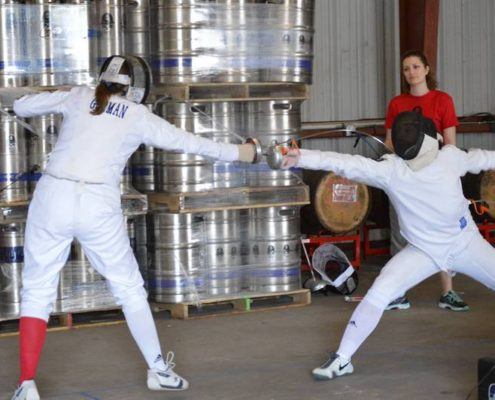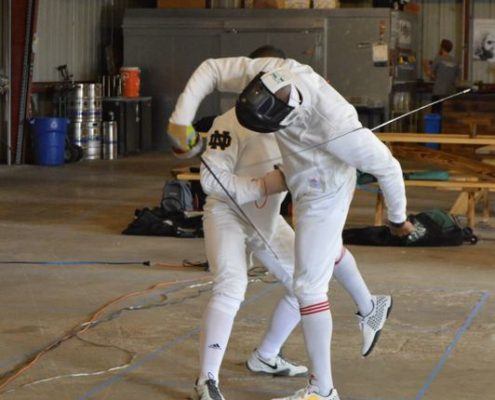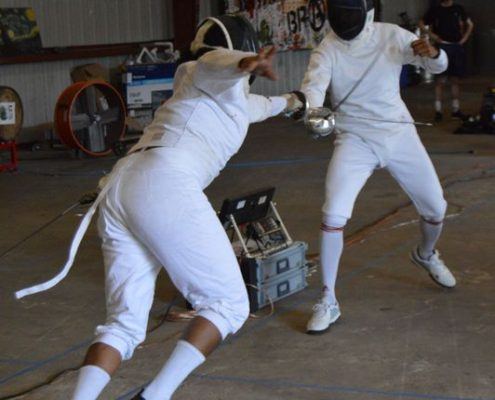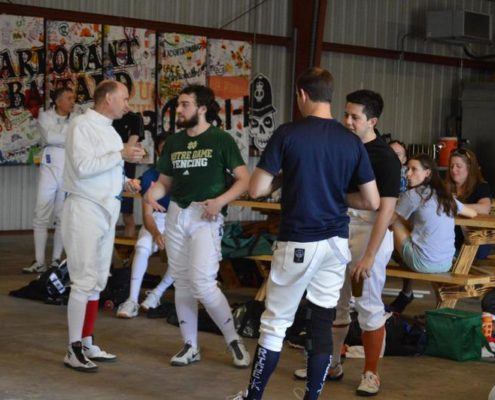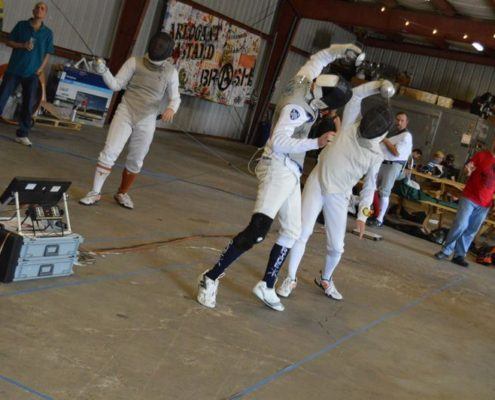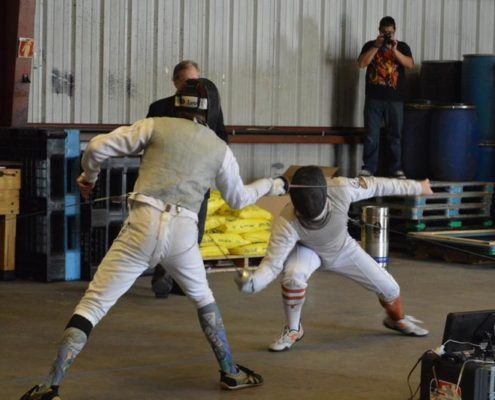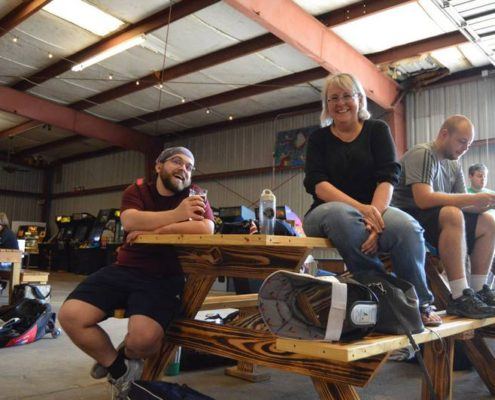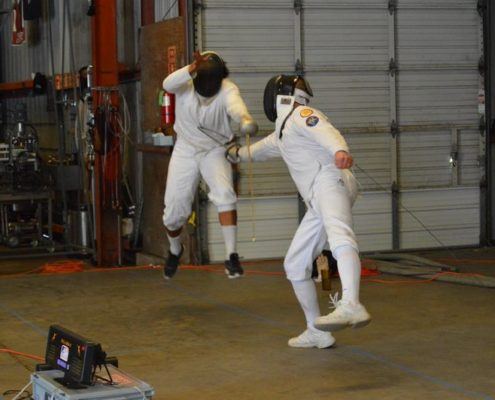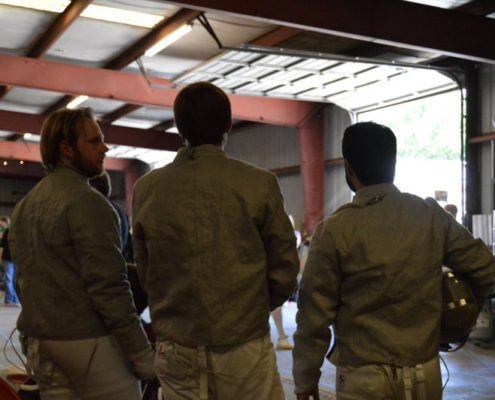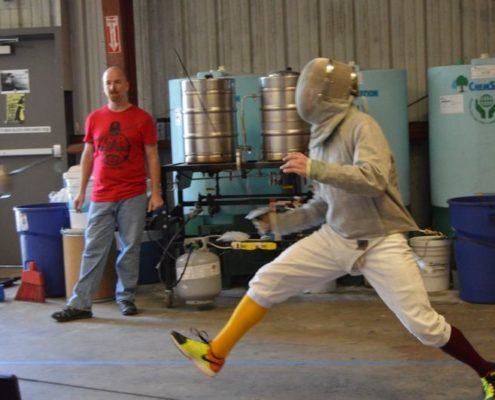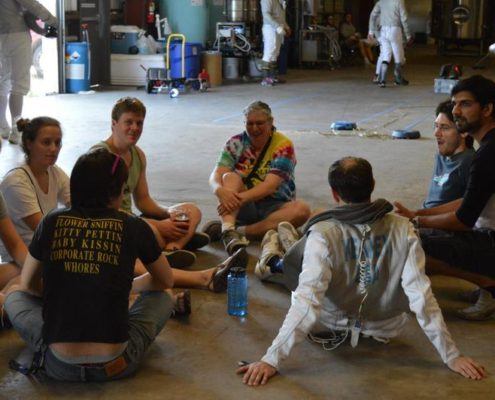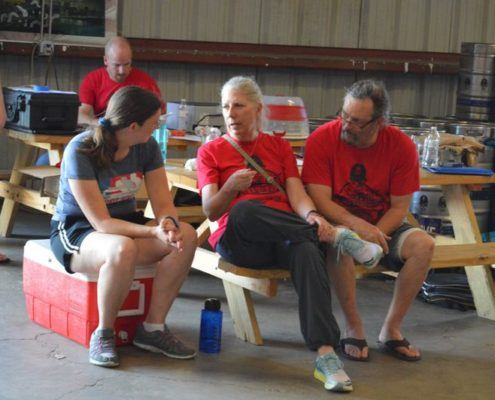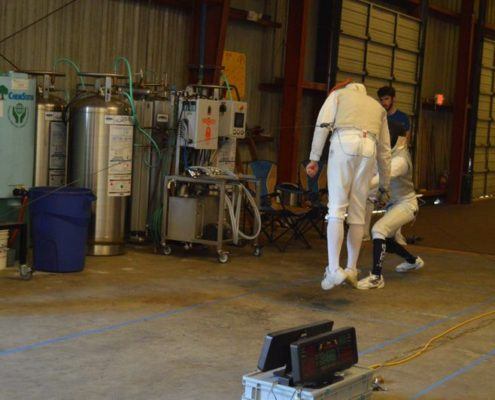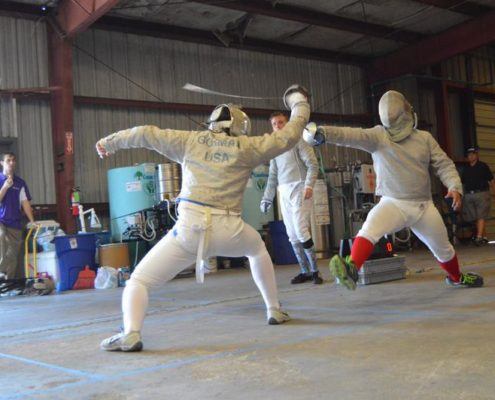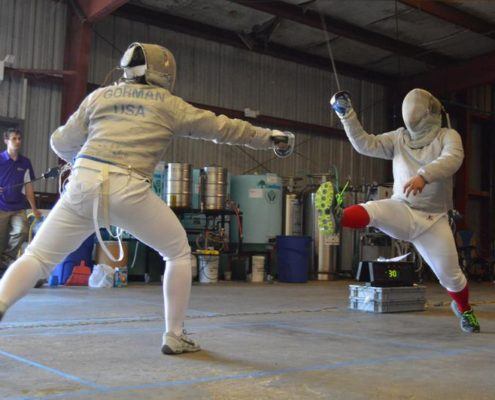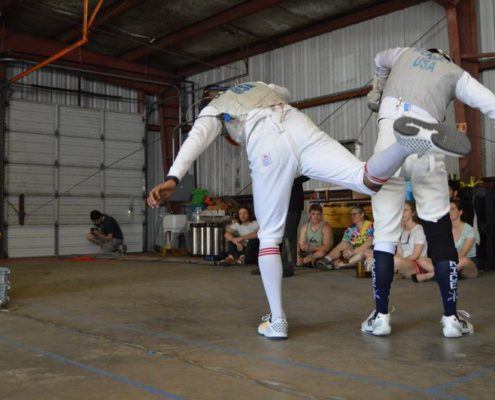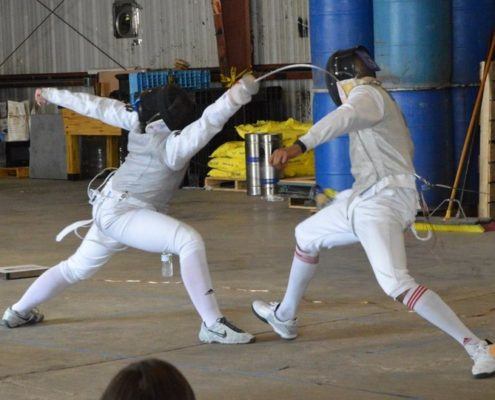The Future of Fencing: The Dual Meet Format
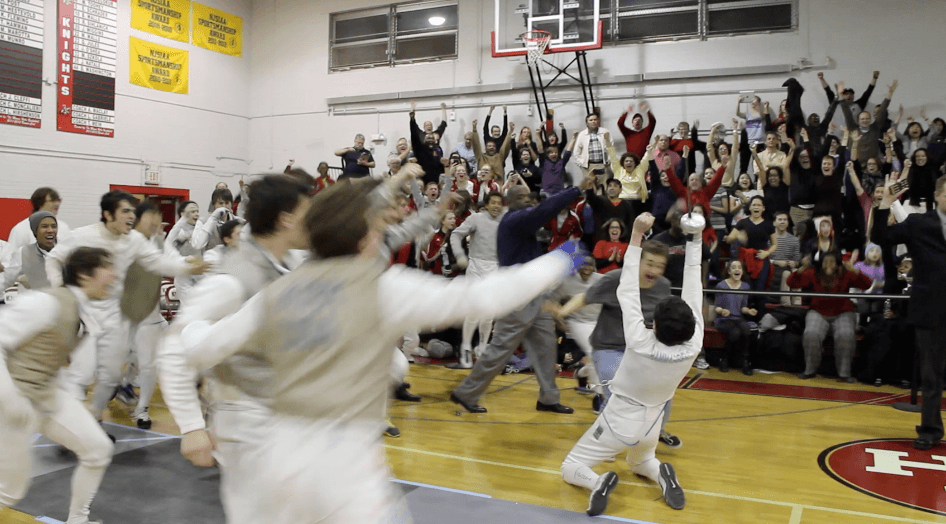
Victory at the NJISAA Team Championships. Photo Credit: fencingfortheedge.wordpress.com
The International Fencing Federation (FIE) has a stated goal of making fencing more audience friendly and many of the rule changes over the past 10-15 years have been made in this interest. This blog post is about two aspects of that, that I feel are generally overlooked – bout length and connection.
Generally speaking, people watch sports that they feel an emotional connection to and have a narrative they can get into. Individual fencing bouts satisfy neither of these needs for the casual viewer – few fencers are known outside the fencing community and a 10 minute DE match doesn’t give much time to engage on a visceral level. A possible solution that addresses these concerns is the dual meet.
Format
The dual meet format is used by the NCAA in intercollegiate competition. The premise is simple: there are men’s and women’s teams and each team has 3 squads – one per weapon. The individual squads are made up of 3 members. Each squad member fences each of the squad members from the other team for a total of 9 bouts. Each team is allowed one substitution[1].
This format gives 9 bouts each in foil, epee, and saber, for a total of 27 bouts between the schools. Whoever wins 14 or more is the victor. This leads to swings in the bout totals as the match progresses, creating interest, connection, and excitement. One team may suffer narrow losses of 4-5 and 3-6 in foil and epee, only to crush their rivals 7-2 in saber and snatch victory from defeat in the final match. With time for the excitement to build, the payoff is greater.
Each round starts fresh, so a team can choose who will compete at the beginning of each round. If they have 7 foilists, they can rotate through them in different rounds. This means that larger schools can rotate in newer fencers, either to crush schools they’re confident of beating, or as sacrificial lambs when they know they’ll lose.
Why Dual Meets
This format also gives a quick path to connection. While individual fencers are relatively obscure, a team would represent a larger, more known entity. A local league could be sponsored by local businesses, neighborhoods, or schools. Universities have alumni followings that will care if a rival is defeated. A meet like this would require one strip and could take place on a stage in front of seating.
Events similar to this occurred in the past involving multiple bouts between pairs of individual fencers, much like a boxing or mixed martial art competition does today. Fencing had famous fencers then, which it lacks now. Boxing matches largely are covered only when one of a handful of known boxers are fighting. MMA had a surge in popularity a few years back, but has seen TV ratings decline fairly steadily over the last year barring a few fights involving, you guessed it, the more famous fighters.
Tennis and golf have seen similar declines in ratings when they’ve lacked marquee players. By using known entities for teams, the dual meet format circumvents the lack of famous fencers and makes a quick connection to potential fans.
Logistics for Schools
The dual meet format has other benefits for a sport like fencing as well. This format allows multiple schools to gather in one location and hold successive meets with other schools. January 30-31, 2016, saw 18 schools compete at the Northwestern Duals in Evanston, IL, over 2 days. Each school would have potentially competed in up to 17 dual meets that weekend. Gathering this number of teams, referees, and other resources in one area allows a team to save on travel money, reduce the time lost from school or work, and reduce the costs associated from running an event by spreading it over more people. This allows teams from different areas to meet and compete with a common format.
Conclusion
The dual meet format has advantages for fencers, tournament organizers, and audience members. The teams can be seeded and meet order can be determined at the beginning of the day, so there are no periods in the tournament where the organizers are furiously entering data and checking numbers while the fencers sit around with nothing to do – data from one round can be entered while the next round is in progress. Fencers get more fencing and less downtime, and the downtime they do get is predictable – fencers and refs alike know when lunch will be and how long they have to eat (and, in the case of epee, nap). Audience members, be they parents, friends, alumni or casual passers-by, have an easier time finding the team they want to root for and following them throughout the day.
The other most common team formats try to take the structure of an individual tournament and apply it to teams of three people. But team events have their own needs and their own dynamics. They should have their own format, too.
[1] Each team has one person designated as a substitute who can be put in for a starter during an encounter. Once in, the sub stays in for the rest of the encounter. Once out, the starter is out for the remainder of that encounter.
Tournament Stories by Coach Liz
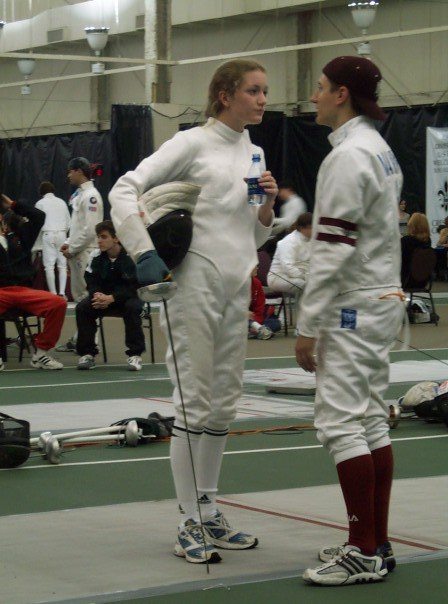
Getting some coaching from my then-boyfriend, now-husband David. I think this was the Crescent City, it would have been 2003 or so.
Coach Liz here. The 2016-2017 season is starting and it’s got me thinking about some of my favorite tournament stories. Here they are, for your enjoyment.
Non-Combativity in Women’s Epee – Tale as Old as 2003 or so
When I first got started I wasn’t good enough to be worthy of a rivalry with anybody, but I did come up against the same people a lot. There was one really great epeeist, we’ll call her Margaret (not her name), who was very tall, very strong, and fairly passive… until you tried to attack or something, and then she’d mow you down with this fleche that I couldn’t do anything about. At one tournament I realized that if I just didn’t attack, she wouldn’t fleche, so I could lose the bout with a shred of dignity and no bruises (give me a break, I was new). The joke was on me because they’d just introduced (reintroduced? decided to enforce?) non-combativity, so when we went a minute without doing anything we both got carded. Margaret thought it was on me to try to score so she shouldn’t have gotten penalized, but apparently not.
I lost that bout, are you surprised?
My First Rating
At another tournament, I fenced a DE bout against a fencer I’d never beaten before, but I was having a great day and won. I was very excited because I’d gotten into the top four, and earned my first rating, an E2005 (I think that was the year). I’d been fencing for three years at that point and had come close to earning a rating several times but never succeeded.[1] Just before my next bout, a semifinal, someone told me that the tournament was better than I’d thought and I’d actually just earned a D (which is better than an E). I was so shocked I forgot how to fence and lost the next bout. Oops.
Let the Ref Check your Stuff
A few years later, my first DE in the women’s event got pretty interesting. My opponent’s blade failed to register a touch pretty early in the bout. When she realized it wasn’t working, she began testing it herself to try to figure out where the problem was. This is a good idea during practice but a terrible idea during a tournament – if something is wrong with your weapon, you need to ask the referee to check it so that the ref knows you didn’t just deliberately sabotage your equipment. If the ref checks your equipment and finds that it’s broken, they will often annul your opponent’s last touch since clearly you couldn’t have scored. But if you check your own stuff, they will not annul the touch.
Well, the trick here is that it wasn’t her fault that her weapon had stopped working – the floor cord had come unplugged, all the way at the end of the strip, where she couldn’t have manipulated it. The ref decided not to annul my last touch because she had tested her own stuff, and the bout committee backed him. I have asked a lot of refs about this call in the years since, and most of them say my touch should have been annulled since she couldn’t have caused the issue. Whatever the correct call was, the ref made the call they made, and my opponent got furious.
She spent the rest of the bout getting increasingly frustrated with her inability to hit me. At the break my husband overheard her saying to her coach “I have never seen someone get so many lucky touches in my LIFE.” I wasn’t getting lucky touches, though. She was so mad that she was trying to hit me hard, whether consciously or subconsciously. Every time she attacked she’d pull her arm back and I’d neatly, lightly counterattack her arm. Then she’d slam into me with the force of a thousand suns (or a 110-lb teenage epee fencer) a split second after I’d already gotten the point. I began to get a little worried for my safety after one particularly savage blow to my knee (epee fencing tip: when you are mad and getting counterattacked, do not aim low, you only make their job easier). I walked away from that bout with about 12 bruises and a victory.
Time to Go!
Later in the same tournament, I ended up in priority. This means that the score was tied and we had run out of time. Priority in fencing means the referee tosses a coin and then you fence for one minute. If somebody gets a point, they win and the bout is over. If nobody gets a point, the winner of the coin toss wins the bout. I lost the coin toss, so my only path to victory was to hit this girl. We were fencing on a strip that had the clock displayed, and my opponent smartly maneuvered me to the point that I couldn’t see it. I wasn’t too concerned because I thought I had a pretty good idea of how long a minute lasts, so I was biding my time and waiting for the perfect moment. Well, I waited a bit longer than I meant to. I heard a few people start to yell “Go! Go!” and my husband said “Uh… Liz?” in the same tone he uses when I’ve forgotten something important like my keys on the way out the door. I realized this meant it was time to attack. So I lunged, and hit her, and turned around and there was one second left on the clock. Thanks for the coaching, honey!
Bad News, Good News
I won the next bout, too, and went to the final. I was fencing better that day than I ever had in my life, but that also means more fencing than I’d ever done in my life, and the fatigue was setting in, and I could barely hold my epee anymore. Sometime between the semifinal and the final I lost my glove. That was the bad news. The only glove we could find at that point was an old, stiff leather glove in size large. The good news was that because it was big and stiff, it actually helped me hold the epee. It felt like I had a little scaffold around my hand. With the help of that glove I won the final bout and earned my first individual gold medal.
A few months later I found out that one of my teammates had taken the glove home thinking it was his even though it had “Liz M” written on the cuff.
Want some stories of your own? Sign up for tournaments! The Cougar Call to Arms is coming up September 17-18 right here in Houston. Also, buy a 2017 calendar and then circle February 11, because that’s the second ever Brash Brewery Bash.
[1] You earn ratings by placing highly in a tournament of a certain size; the rating A-E depends on your placement and the size of the tournament, and the year you earned it in follows the letter.
Our B.S. (Brash Summary) – with pictures!

Yes! The tournament went so well!
A few weeks ago I posted about the Houston Sword Sports Brash Invitational – a 21 & up tournament in a brewery, with beer for prizes. We pulled it off, and it went great! These types of events are a great way to build recreational fencing and bring the community together, and I want to encourage more clubs to try holding them.
One of our fencers was talking to someone at the national office recently and they wondered why these things aren’t more common, and how to encourage them. For us, it was just about having the idea in the first place. It was pretty easy to organize once we knew what we wanted to do.
Now, we didn’t come up with the idea. The Galveston and Clear Lake fencing clubs, also in the Gulf Coast division, have been running a tournament at a winery for several years (they just held the fifth). Last year, they added a tournament at a rum/tequila/vodka distillery. Both of these events were small, one-weapon tournaments for fencers over 21 and were capped at 16 participants. In both cases the venues were small, so there were two (short) strips.
Last year I was in one of Houston’s many fantastic microbreweries and thought to ask if they would be willing to host a tournament. It didn’t work out with that one, but through some contacts we got in touch with the owner of Brash Brewing. They have a large warehouse where they regularly host concerts, so we were able to expand beyond our original vision (a foil tournament to complement the other two) and host a three-weapon tournament. They didn’t charge us to use the space, and stayed open to the public. It is an un-airconditioned warehouse and got pretty warm as the day wore on, but it was a great size. We had six strips but could have done eight easily (not that we needed them); our strips were a little short but we could’ve made them full-length if we wanted to.

Davis and Carlos in the epee gold medal bout; you can see our audience and the bar in the background.
We have a club member who’s a fantastic artist, who designed a shirt for us to sell at the event. We went with a local screenprinting company, Bayou City Shirts, and everything on their end went really quickly and smoothly. We were a little too conservative with our preorders and sold out of all sizes except small, so next year we’ll order more shirts. The shirts ended up saving us in terms of the profitability of the tournament – most of the money we made went to pay for beer and food, so the profits from the shirts were a good cushion.
One of our club members works for a company that has a community service program, and she got us listed as an option for that, so we had some volunteers to help with the non-reffing aspects of running a tournament. They set up and tore down strips, one guy did equipment control, and another guy ran the tournament computer for most of the day. We had more helpers than we needed, but they had a good time and a lot of stuff ran really smoothly because they were around.

Well, most of the volunteers had a good time. Some found the whole thing a little confusing.
We had all three events capped at 16 participants. Epee filled up fast so we raised the cap to 24. We had 22 preregister for epee, 12 for foil and 14 for saber, but we had a lot of no-shows so epee was 17 and foil and saber were both at 10. These were good sizes, and we kept the events moving along pretty well in spite of a number of fencers doing multiple events.
Once someone was eliminated from all their events, they came to the bout committee for a ticket that they could use at the bar to get a beer. Multiple events = multiple tickets. We had a running (enormous) tab and this helped us make sure people got the right number of beers and helped the bartenders know which beers to put on our tab.

Carlos with his two beery prizes (for second place) and one post-tournament beer.
As for the fencing, we had a wide variety of fencers – some who’d been fencing for ages and a few who were basically beginners. There were some fencers who were also doing weapons they don’t usually fence, hoping to win the best-overall-result prize. The people who were just there to have a good time did have a good time, and the more serious fencers also got some good bouts in.
The tournament was a blast, but there are a couple things we will do differently next year. We want to have a staff member whose primary job is to talk to the folks who are at the brewery for beer, to explain what’s going on and get email signups for anyone who wants to try fencing. The biggest change is that we definitely want to hold it earlier in the year. The end of April in Houston is just too hot for a semi-outdoor, unairconditioned tournament. We had a few people who had planned on fencing multiple events but as the day wore on it got to be too hot for them. Depending on the time of year, we may also reverse the order of events so that the most-lame’d people are fencing earlier in the day and the epeeists are last, so you shed layers as the temperature warms up.

It was hot. Some people got tired.
We got over 500 amazing pictures from the tournament thanks to club member Kat Kelsch-Tournier. You can view the full album here, but I’ve pulled out a few (dozen) of my favorites below.
Are you a fencer who wants to come to next year’s Brash? Sign up for our mailing list to find out when it’s happening! Are you a club owner who wants to hold your own brewery tournament? Email me at liz@houstonswordsports.com if you have any questions, or if you want us to send your tournament info to our list!

